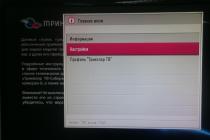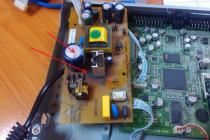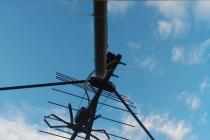Electrical devices and secondary circuits of protection, control, signaling and measurement circuits are tested to the extent specified in this paragraph. Electrical wiring with voltage up to 1 kV from distribution points to electrical receivers are tested according to claim 1.
1. Measurement of insulation resistance.
2. Test with increased voltage of industrial frequency.
Test voltage for secondary circuits of protection, control, signaling and measurement circuits with all connecting devices (automatic switches, magnetic starters, contactors, relays, devices, etc.) 1 kV. The duration of the application of the standardized test voltage is 1 min.
3. Checking the action circuit breakers.
3.1. Insulation resistance test. It is produced for circuit breakers with a rated current of 400 A and more. Insulation resistance value - not less than 1 megohm.
3.2. Checking the action of the releases. The action of the instantaneous release is checked. The breaker shall operate at a current not exceeding 1.1 times the upper value of the breaker trip current specified by the manufacturer.
In electrical installations made in accordance with the requirements of section, chapters 7.1 and 7.2, all input and sectional switches, switches for emergency lighting, fire alarm and automatic fire extinguishing circuits, as well as at least 2% of switches of distribution and group networks are checked.
In other electrical installations, all lead-in and sectional switches, switches for emergency lighting, fire alarm and automatic fire extinguishing circuits, as well as at least 1% of the remaining switches are tested.
The check is carried out in accordance with the instructions of the manufacturers. When detecting switches that do not meet the established requirements, the double number of switches is additionally checked.
4. Checking the operation of circuit breakers and contactors at reduced and rated operating current voltages.
The value of the operating voltage and the number of operations when testing circuit breakers and contactors by multiple switching on and off are given in table. 1.8.35.
5. Residual current devices (RCDs), residual current circuit breakers (RCDs) are checked in accordance with the manufacturer's instructions.
6. Checking relay equipment. Testing of protection, control, automation and signaling relays and other devices is carried out in accordance with the current instructions. The limits of operation of the relay at the operating settings must correspond to the calculated data.
7. Verification of correct functioning of fully assembled circuits at various values of the operating current.
All circuit elements must function reliably in the sequence provided for by the project at the operating current values given in Table. 1.8.36.
Table 1.8.34
Insulation resistance values
|
Test item |
Megohmmeter voltage, V |
The smallest admissible value of insulation resistance, MOhm |
|
1. DC buses on control panels and in switchgears (with disconnected circuits) |
||
|
3. Control, protection, automation and measurement circuits, as well as excitation circuits of DC machines connected to power circuits |
||
|
4. Secondary circuits and elements when powered from a separate source or through an isolating transformer, designed for an operating voltage of 60 V and below |
||
1) Measurement is carried out with all connected devices (drive coils, contactors, starters, circuit breakers, relays, instruments, secondary windings of current and voltage transformers, etc.).
2) Measures should be taken to prevent damage to devices, especially microelectronic and semiconductor components.
3) Insulation resistance is measured between each wire and ground, and between every two wires.
4) The insulation resistance of each section of the switchgear is measured.
Table 1.8.35
Testing contactors and circuit breakers by repeated switching on and off
Electrical devices, secondary circuits and wiring with voltage up to 1 kV
Electrical devices and secondary circuits of protection, control, signaling and measurement circuits are tested to the extent specified in this paragraph. Electrical wiring with voltage up to 1 kV from distribution points to electrical receivers are tested according to claim 1.
1. Measurement of insulation resistance.
Insulation resistance should be not less than the values given in table 1.8.34.
Table 1.8.34 Permissible values of insulation resistance
| Test item | Megohmmeter voltage, V | The smallest admissible value of insulation resistance, MOhm |
1. DC buses on control panels and in switchgears (with disconnected circuits) |
500-1000 | 10 |
|
2. Secondary circuits of each connection and supply circuits of drives of switches and disconnectors |
500-1000 | 1 |
3. Control, protection, automation and measurement circuits, as well as excitation circuits of DC machines connected to power circuits |
500-1000 | 1 |
4. Secondary circuits and elements when powered from a separate source or through an isolating transformer, designed for an operating voltage of 60 V and below |
500 | 0,5 |
5. Electrical wiring, including lighting networks |
1000 | 0,5 |
6. Switchgears, boards and conductors (busbars) |
500-1000 | 0,5 |
The measurement is carried out with all connected devices (drive coils, contactors, starters, circuit breakers, relays, instruments, secondary windings of current and voltage transformers, etc.).
Measures should be taken to prevent damage to devices, especially microelectronic and semiconductor components.
* Insulation resistance is measured between each wire and ground, and between every two wires.
________________
* No footnote in the table. - Note "CODE".
The insulation resistance of each section of the switchgear is measured.
2. Test with increased voltage of industrial frequency.
Test voltage for secondary circuits of protection, control, signaling and measurement circuits with all connecting devices (automatic switches, magnetic starters, contactors, relays, devices, etc.) 1 kV. The duration of the application of the standardized test voltage is 1 min.
3. Checking the operation of the circuit breakers.
3.1. Insulation resistance test. It is produced for circuit breakers with a rated current of 400 A and more. Insulation resistance value - not less than 1 megohm.
3.2. Checking the action of the releases. The action of the instantaneous release is checked. The breaker shall operate at a current not exceeding 1.1 times the upper value of the breaker trip current specified by the manufacturer.
In electrical installations made in accordance with the requirements of section 6, chapters 7.1 and 7.2, all input and sectional switches, switches for emergency lighting, fire alarm and automatic fire extinguishing circuits, as well as at least 2% of switches of distribution and group networks are checked.
In other electrical installations, all lead-in and sectional switches, switches for emergency lighting, fire alarm and automatic fire extinguishing circuits, as well as at least 1% of the remaining switches are tested.
The check is carried out in accordance with the instructions of the manufacturers. When detecting switches that do not meet the established requirements, the double number of switches is additionally checked.
4. Checking the operation of circuit breakers and contactors at reduced and rated operating current voltages.
The value of the operating voltage and the number of operations when testing circuit breakers and contactors by multiple switching on and off are given in Table 1.8.35.
Table 1.8.35 Testing contactors and circuit breakers by multiple switching on and off
5. Residual current devices (RCD), residual current circuit breakers (RCD) checked in accordance with the manufacturer's instructions.
6. Checking relay equipment. Testing of protection, control, automation and signaling relays and other devices is carried out in accordance with the current instructions. The limits of operation of the relay at the operating settings must correspond to the calculated data.
7. Verification of correct functioning of fully assembled circuits at various values of the operating current.
All circuit elements must function reliably in the sequence envisaged by the project at the operating current values given in Table 1.8.36.
Table 1.8.36 Auxiliary current voltage at which the normal operation of the circuits should be ensured
| Test object | Operating voltage,% of nominal | Note |
Protection and signaling circuits in installations with voltages above 1kV |
80, 100 | - |
Control circuits in installations with voltages above 1 kV: turn-on test |
90, 100 | - |
the same, but on disconnection |
80, 100 | - |
Relay-contactor circuits in installations with voltage up to 1 kV |
90, 100 | For simple circuits, the button is a magnetic starter, the check for operation at low voltage is not performed. |
Logic contactless circuits |
85, 100, 110 | The voltage change is made at the input to the power supply. |
Oil-filled transformers power up to 630 kVA are tested according to clauses 1, 2 (only insulation resistance), 11-14.
Oil-filled transformers with a capacity of up to 1.6 MVA are tested according to clauses 1, 2, 4, 9, 11-14.
Oil-filled transformers with a capacity of more than 1.6 MVA, as well as transformers for auxiliary needs of power plants, regardless of their capacity, are tested in full, provided for in this paragraph.
Dry and filled with a non-combustible liquid dielectric transformers of all capacities are tested according to clauses 1-7, 12, 14.
1. Determination of the conditions for switching on transformers.
Should be produced in accordance with the manufacturer's instructions.
2. Measurement of insulation characteristics.
For transformers with voltages up to 35 kV inclusive with a capacity of up to 10 MVA and arc suppression reactors, the insulation resistance of the windings must not be lower than the following values:
The insulation resistance of dry transformers at a temperature of 20-30 ºС should be for windings with a rated voltage:
Up to 1 kV inclusive - not less than 100 MOhm;
More than 1 kV up to 6 kV - not less than 300 MOhm;
More than 6 kV - not less than 500 megohms.
For other transformers, the insulation resistance, reduced to the measurement temperature at the factory, must be at least 50% of the original value.
The values of the tangent of the angle of dielectric losses (tan δ), reduced to the measurement temperature at the factory, should not differ from the initial values in the direction of deterioration by more than 50%.
Measurement of insulation resistance and tan δ should be carried out at a winding temperature not lower than:
10 ºС - for transformers with voltage up to 150 kV;
20 ºС - for transformers with a voltage of 220-750 kV.
Measurement of tan δ on transformers up to 1600 kVA is optional.
Measurement of the insulation resistance of accessible tie rods, bandages, half-bandages with a yoke and pressing rings relative to active steel and electrostatic screens, relative to the windings and the magnetic circuit is carried out in the case of inspecting the active part. The measured values must be at least 2 MΩ, and the insulation of the yoke beams must be at least 0.5 MΩ. Measurements are made with a 1000 V megohmmeter.
3. Test with increased voltage of industrial frequency:
a) insulation of windings together with inputs. Test voltages are given in table. 1.8.12... The duration of the application of the standardized test voltage is 1 min.
It is not necessary to test the insulation of the windings of oil-filled transformers with increased voltage at the industrial frequency.
Testing with increased voltage of industrial frequency of insulation of windings of dry transformers is mandatory and is carried out according to the norms of table. 1.8.12 for apparatus with lightweight insulation.
Imported transformers are allowed to be tested with voltages indicated in table. 1.8.12, only in cases where they do not exceed the voltage with which this transformer was tested at the factory.
Test voltages of grounding reactors for voltages up to 35 kV are similar to those given for transformers of the corresponding class;
b) insulating accessible tie rods, press rings and yoke beams. The test should be carried out in the case of inspection of the active part. Test voltage 1 kV. The duration of the application of the standardized test voltage is 1 min.
4. Measurement of resistance of windings to direct current.
Produced on all branches. The resistance should differ by no more than 2% from the resistance obtained on the same branch of other phases, or from the manufacturer's data.
The resistance value of the windings of single-phase transformers after temperature recalculation should not differ by more than 5% from the initial values.
5. Checking the transformation ratio.
It is carried out at all stages of switching. The transformation ratio should differ by no more than 2% from the values obtained on the same branch on other phases, or from the manufacturer's data. For transformers with on-load tap-changers, the difference between the transformation ratios should not exceed the value of the control step.
6. Checking the connection group of three-phase transformers and the polarity of the terminals of single-phase transformers.
It is carried out if there are no passport data or there are doubts about the reliability of these data. The group of connections must correspond to the passport data and designations on the plate.
7. Measurement of no-load losses.
Measurements are carried out for transformers with a capacity of 1000 kVA and more at a voltage supplied to the low voltage winding equal to that specified in the factory test report (passport), but not more than 380 V. In three-phase transformers, no-load losses are measured with single-phase excitation according to the schemes used at the factory.
For three-phase transformers during commissioning, the ratio of losses on different phases should not differ from the ratios given in the factory test report (passport) by more than 5%.
For single-phase transformers, during commissioning, the difference between the measured loss values and the original ones should not exceed 10%.
7.1. Measurement of the short-circuit resistance (Z to) of the transformer.
The measurement is carried out for transformers 125 MB · A and more.
For transformers with on-load voltage regulation, Z k is measured at the main and both extreme taps.
The values of Z to should not exceed the value determined by the short-circuit voltage (u to) of the transformer on the main branch by more than 5%.
8. Checking the operation of the switching device.
Manufactured in accordance with the manufacturer's instructions.
9. Testing a tank with radiators.
All transformers are tested, except for sealed and without an expander. The test is carried out:
For transformers with voltages up to 35 kV inclusive - the hydraulic pressure of the oil column, the height of which above the level of the filled expander is 0.6 m, with the exception of transformers with wavy tanks and plate radiators, for which the height of the oil column is taken equal to 0.3 m;
For transformers with film protection of oil - creating an excess air pressure of 10 kPa inside the flexible shell;
For other transformers - by creating an overpressure of nitrogen or dry air of 10 kPa in the over-oil space of the expander.
The duration of the test in all cases is at least 3 hours. The temperature of the oil in the tank when testing transformers with voltages up to 150 kV inclusive is at least 10 ºС, the rest - at least 20 ºС.
The transformer is considered oil-tight if no oil leak is found by inspection after the test.
Power cable lines
Power cable lines with voltage up to 1 kV are tested according to clauses 1, 2, 7, 13, voltage above 1 kV and up to 35 kV - according to clauses 1-3, 6, 7, 11, 13, voltage 110 kV and above - in in full, provided for in this paragraph.
1. Checking the integrity and phasing of the cable cores. The integrity and coincidence of the designations of the phases of the connected cable cores are checked.
2. Measurement of insulation resistance. Produced with a 2.5 kV megohmmeter. For power cables up to 1 kV, the insulation resistance must be at least 0.5 MΩ. For power cables above 1 kV, the insulation resistance is not standardized. Measurement should be made before and after overvoltage testing of the cable.
3. Test with increased voltage of rectified current.
The test voltage is taken in accordance with Table 1.8.39.
Table 1.8.39 Rectified current test voltage for power cables
________________
* Rectified voltage tests of single-core cables with plastic insulation without armor (screens), laid in the air, are not performed.
For cables for voltages up to 35 kV with paper and plastic insulation, the duration of application of the full test voltage is 10 minutes.
For cables with rubber insulation for voltage 3-10 kV, the duration of application of the full test voltage is 5 minutes. Rubber-insulated cables for voltages up to 1 kV are not subjected to overvoltage tests.
For cables with a voltage of 110-500 kV, the duration of application of the full test voltage is 15 minutes.
The permissible leakage currents depending on the test voltage and the permissible values of the asymmetry coefficient when measuring the leakage current are given in Table 1.8.40. Absolute value leakage current is not a rejection indicator. Satisfactorily insulated cable lines must have stable leakage currents. The leakage current shall decrease during the test. If there is no decrease in the value of the leakage current, as well as with its increase or instability of the current, the test should be carried out until the defect is detected, but not more than 15 minutes.
Table 1.8.40 Leakage currents and unbalance factors for power cables
| Voltage cables, kV | Test voltage, kV | Permissible leakage currents, mA | Allowable values of the asymmetry coefficient () |
| 6 | 36 | 0.2 | 8 |
| 10 | 60 | 0.5 | 8 |
| 20 | 100 | 1.5 | 10 |
| 35 | 175 | 2.5 | 10 |
| 110 | 285 | Not standardized | Not standardized |
| 150 | 347 | Also | Also |
| 220 | 610 | " | " |
| 330 | 670 | " | " |
| 500 | 865 | " | " |
With mixed laying of cables, as the test voltage for the entire cable line, take the lowest of the test voltages according to Table 1.8.39.
4. Testing by voltage of alternating current of frequency of 50 Hz.
This test is allowed for cable lines for a voltage of 110-500 kV instead of testing with a rectified voltage.
The test is performed with voltage (1.00-1.73). It is allowed to carry out tests by switching on the cable line to the rated voltage. Test duration - according to the manufacturer's instructions.
5. Determination of the active resistance of the conductors. Produced for lines 20 kV and above. The active resistance of the conductors of the cable line to direct current, reduced to 1 mm of cross-section, 1 m of length and a temperature of +20 ° C, should be no more than 0.0179 Ohm for a copper conductor and no more than 0.0294 Ohm for an aluminum conductor. The measured resistance (reduced to specific value) may differ from specified values no more than 5%.
6. Determination of the electrical working capacity of the conductors.
Produced for lines 20 kV and above. The measured capacity should not differ from the factory test results by more than 5%.
7. Checking protection against stray currents.
The operation of the installed cathodic protections is checked.
8. Test for the presence of undissolved air (impregnation test).
Produced for 110-500 kV oil-filled cable lines. The content of undissolved air in the oil should be no more than 0.1%.
9. Test of feeding units and automatic heating of end couplings.
Produced for 110-500 kV oil-filled cable lines.
10. Checking anti-corrosion protection.
When accepting lines for operation and during operation, the operation of anti-corrosion protections is checked for:
Cables with a metal sheath, laid in soils with medium and low corrosive activity (soil resistivity above 20 Ohm / m), with an average daily earth leakage current density above 0.15 mA / dm;
Cables with a metal sheath, laid in soils with high corrosive activity (soil resistivity less than 20 Ohm / m) at any average daily current density into the ground;
Cables with an unprotected sheath and destroyed armor and protective covers;
Steel pipeline of high-pressure cables, regardless of the aggressiveness of the soil and types of insulating coatings.
The test measures the potentials and currents in the sheaths of the cables and the parameters of electrical protection (current and voltage of the cathode station, drainage current) in accordance with the guidelines for the electrochemical protection of underground power facilities against corrosion.
The assessment of the corrosiveness of soils and natural waters should be carried out in accordance with the requirements of GOST 9.602-89.
11. Determination of the characteristics of oil and insulating liquid.
The determination is made for all elements of oil-filled cable lines for a voltage of 110-500 kV and for end couplings (inputs to transformers and switchgear) of cables with plastic insulation for a voltage of 110 kV.
Samples of oils of grades S-220, MN-3 and MN-4 and insulating liquid of PMS grade must meet the requirements of the standards of tables 1.8.41 and 1.8.42.
Table 1.8.41 Standards for quality indicators of S-220, MN-3 and MN-4 oils and PMS grade insulating liquid
Note. Tests of oils not listed in Table 1.8.39 should be performed in accordance with the manufacturer's requirements.
Table 1.8.42 Tangent of the angle of dielectric losses of oil and insulating liquid (at 100,%, not more, for cables for voltage, kV)
| 110 | 150-220 | 330-500 |
| 0,5/0,8* | 0,5/0,8* | 0,5/- |
________________
* The numerator indicates the value for oils of the S-220 brands, in the denominator - for MN-3, MN-4 and PMS
If the values of the electrical strength and the degree of degassing of the MH-4 oil comply with the standards, and the tan δ values measured according to the GOST 6581-75 method exceed those indicated in Table 1.8.42, the oil sample is additionally kept at a temperature of 100 ° C for 2 hours, measuring periodically. With a decrease in the tan δ value, the oil sample is kept at a temperature of 100 ° C until a steady-state value is obtained, which is taken as a reference value.
12. Measurement of grounding resistance.
It is produced on lines of all voltages for end terminations, and on 110-500 kV lines, in addition, for metal structures of cable wells and make-up points.














